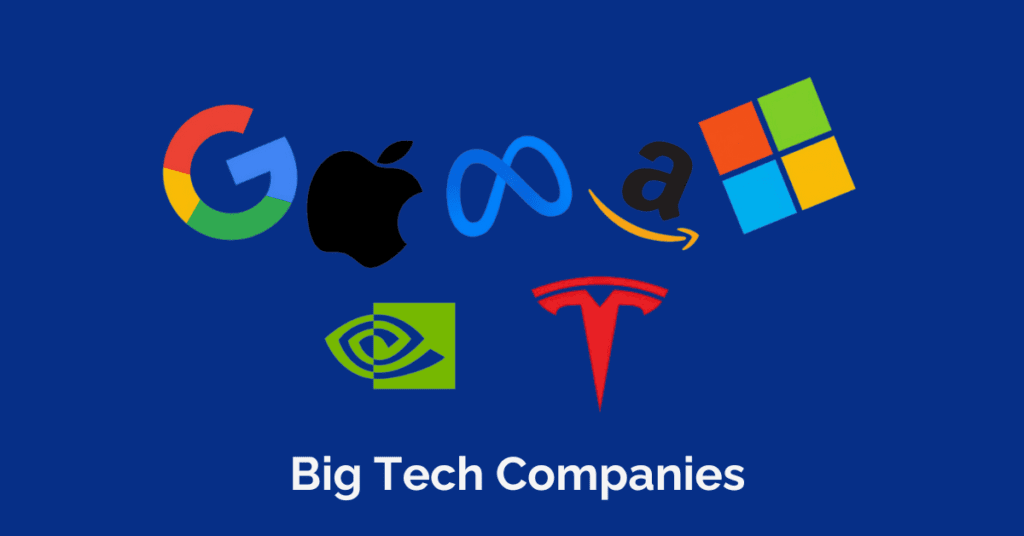
July 15, 2024

The term “Big Tech Companies” or “Big Tech Giants” refers to a group of technologically advanced companies that have grown to wield significant influence in the world.
These companies are at the forefront of innovation, developing products and services that touch nearly every aspect of our lives.
There’s no single, universally agreed-upon list of Big Tech companies. However, some of the most commonly mentioned names include:
These companies are often grouped based on their market capitalization (total market value) or their influence in specific sectors like online advertising, e-commerce, or social media.
It’s important to note that Big Tech isn’t just limited to the US. China also has a strong presence in the tech world, with giants like Alibaba, Baidu, and Tencent often referred to as the “BATX” companies.

Big Tech companies are the technological titans of our time. They stand out from the crowd with a unique set of characteristics that have propelled them to the forefront of innovation and influence. Let’s discuss the key features that define Big Tech:
By understanding these key features, you gain a deeper understanding of the forces shaping our technological landscape. Big Tech companies are here to stay, and their influence will continue to evolve.
Big Tech companies cast a long shadow, impacting society in numerous ways. Here’s a closer look at both the positive and negative consequences of their influence:
Positive Impacts:
Negative Impacts:
The Overall Impact:
The impact of Big Tech companies is complex and multifaceted. While they offer undeniable benefits, the potential downsides require careful consideration and ongoing discussions. Finding the right balance between innovation, user well-being, and responsible data practices will be crucial in shaping the future of Big Tech and its impact on our world.
Big Tech companies are a powerful force, shaping our world in countless ways. Here’s a detailed look at some of the most prominent players:
Alphabet Inc. is a name synonymous with innovation and technology. While many recognize Google as the internet giant it is today, Alphabet acts as the parent company, housing Google and a variety of other ventures under its umbrella.
From Google to Alphabet: A Strategic Restructuring
In 2015, Google underwent a significant restructuring, emerging as a subsidiary under the newly formed Alphabet Inc. This shift aimed to streamline operations and grant greater autonomy to Google’s burgeoning ventures. Larry Page and Sergey Brin, Google’s co-founders, remained at the helm, with Page leading Alphabet and Sundar Pichai taking over as Google’s CEO.
The Alphabet Constellation: Google and Beyond
Alphabet’s core business lies in Google, the world’s most popular search engine. However, Alphabet encompasses a wider array of enterprises, categorized as “Other Bets.” These ventures represent Alphabet’s diversification into various technological frontiers:
The Impact of Alphabet
Alphabet’s influence is undeniable. Google products like Search, YouTube, and Android operating system have become ingrained in our daily lives. Beyond Google, Alphabet’s “Other Bets” hold the potential to reshape industries, from transportation with Waymo’s self-driving cars to healthcare with Verily’s life sciences pursuits.
The Future of Alphabet
As a relatively young company, Alphabet continues to evolve. The success of Google finances its “Other Bets,” allowing them to take calculated risks in their respective fields. With its vast resources and commitment to innovation, Alphabet is poised to remain a major player in the ever-changing technological landscape.
Amazon.com, Inc., or simply Amazon, has transcended its origins as an online bookstore to become a global behemoth, influencing not just e-commerce but also cloud computing, streaming, and artificial intelligence. Lets explores the history, multifaceted business model, and far-reaching impact of Amazon.
From Humble Beginnings to Retail Dominance
Founded in 1994 by Jeff Bezos, Amazon started as a small online bookseller operating out of his garage. With a focus on customer satisfaction and a vast selection, Amazon quickly disrupted the traditional bookselling industry. The company’s relentless innovation, including features like one-click ordering and personalized recommendations, solidified its position as an e-commerce leader.
A Multifaceted Business Model
Amazon’s success lies in its diversified business model. Here’s a breakdown of its key areas:
The Impact of Amazon
Amazon’s influence is far-reaching. It has:
Challenges and Considerations
Despite its success, Amazon faces challenges:
The Future of Amazon
Amazon’s future is tied to its ability to navigate these challenges while continuing to innovate. The company’s focus on automation, artificial intelligence, and its ever-expanding product and service range suggests it will remain a powerful force in the global marketplace.
Apple Inc. is a name synonymous with sleek design, user-friendly interfaces, and cutting-edge technology. From its humble beginnings in a garage to its current status as a global tech titan, Apple’s story is one of innovation and unwavering dedication to a distinct brand identity.
A History Steeped in Innovation
Founded in 1976 by Steve Jobs, Steve Wozniak, and Ronald Wayne, Apple’s initial focus was on personal computers. The Apple I, designed by Wozniak, was a revolutionary machine for hobbyists, while the Apple II, released in 1977, established Apple as a major player in the early personal computer market.
The visionary leadership of Steve Jobs, however, pushed Apple beyond just hardware. The introduction of the Macintosh in 1984, with its graphical user interface (GUI), marked a significant shift in how people interacted with computers. While initially facing challenges, the Macintosh laid the foundation for future Apple products known for their intuitive design.
A Multi-Product Powerhouse
Apple’s success story extends beyond personal computers. The company has diversified into various product categories, each becoming a hallmark of its brand:
The Apple Ecosystem: A Strength and a Strategy
A core aspect of Apple’s success lies in its tightly integrated ecosystem. Apple devices seamlessly work together, with features like Handoff allowing users to effortlessly transition tasks between devices. Additionally, Apple’s App Store provides a curated selection of applications optimized for its devices, further enhancing the user experience.
The Impact of Apple
Apple’s influence on the tech industry is undeniable. It has:
Challenges and Considerations
Despite its success, Apple faces challenges:
The Future of Apple
With its focus on design, user experience, and continuous innovation, Apple is poised to remain a prominent player in the tech industry. Augmented reality, artificial intelligence, and autonomous vehicles are potential areas where Apple might venture in the future, further shaping the technological landscape.
By understanding Apple’s rich history, diverse product portfolio, and impact on the tech world, we gain a deeper appreciation for the company that continues to be a pioneer in design and innovation.
Meta Platforms Inc., often simply referred to as Meta, is a tech giant that emerged from a 2015 restructuring of Facebook. Though Facebook remains its most well-known product, Meta’s ambitions extend far beyond the social media realm.
From Social Network to Tech Titan: The Rise of Meta
Facebook, founded in 2004 by Mark Zuckerberg, revolutionized online connection. By 2015, however, the company had grown exponentially, encompassing a variety of services like Instagram, WhatsApp, and Oculus VR. To streamline operations and focus on emerging technologies, Facebook became a subsidiary under the newly formed parent company, Meta.
A Multifaceted Business: Beyond the Social Media Feed
Meta’s business extends beyond traditional social media:
The Metaverse: Meta’s Vision for the Future
The concept of the metaverse, a persistent virtual world where users can interact in a simulated space, is central to Meta’s vision. The company envisions the metaverse as the next frontier of social connection, enabling work, entertainment, and socializing in immersive virtual environments.
The Impact of Meta
Meta’s influence is undeniable:
Challenges and Considerations
Meta’s path forward presents complexities:
The Future of Meta
Meta’s future hinges on its ability to navigate these challenges while forging a path towards a responsible and engaging metaverse. The company’s investments in artificial intelligence, research, and development suggest its commitment to shaping the future of connection.
Microsoft Corporation, a household name synonymous with personal computers, has evolved into a multifaceted tech giant. From its humble beginnings developing programming languages to its current dominance in operating systems and productivity software, Microsoft’s story is one of constant innovation and adaptation.
A Foundation Built on Code: The Early Days of Microsoft
Founded in 1975 by Bill Gates and Paul Allen, Microsoft’s initial focus was on developing programming languages. Their creation of an interpreter for the BASIC programming language for the Altair 8800, an early personal computer, marked a pivotal moment. Microsoft recognized the potential of the burgeoning personal computer market and shifted its strategy towards creating software for these machines.
The Dominating Duo: Windows and Office
The launch of MS-DOS (Microsoft Disk Operating System) in 1981, partnered with IBM’s personal computer, was a game-changer. MS-DOS became the dominant operating system for PCs, solidifying Microsoft’s position in the industry. Building upon this success, Microsoft introduced Windows in 1985, a graphical user interface (GUI) that made computers more user-friendly. Over the years, Windows has undergone numerous iterations, becoming the world’s leading operating system for personal computers.
In 1989, Microsoft released another cornerstone product: Microsoft Office. This suite of productivity software, including Word, Excel, and PowerPoint, revolutionized office work. Microsoft Office became the go-to suite for businesses and individuals alike, further entrenching Microsoft’s dominance in the software industry.
Beyond the Desktop: Microsoft’s Diversification
Microsoft has not limited itself to just desktop software. Here’s a glimpse into its diversified offerings:
The Impact of Microsoft
Microsoft’s influence on the tech industry is undeniable:
Challenges and Considerations
Despite its success, Microsoft faces challenges:
The Future of Microsoft
Microsoft’s future lies in its ability to adapt and innovate. The company’s focus on cloud computing, artificial intelligence, and mixed reality suggests its commitment to remaining a relevant force in the ever-changing world of technology.
Nvidia Corporation, a name synonymous with cutting-edge graphics processing units (GPUs), has become a powerhouse in the world of technology. From enabling realistic visuals in video games to powering artificial intelligence applications, Nvidia’s innovations are transforming various industries.
From Humble Beginnings to Silicon Valley Prominence
Founded in 1993 by Jen-Hsun Huang, Chris Malachowsky, and Curtis Priem, Nvidia set its sights on revolutionizing computer graphics. Their initial focus was on developing high-performance graphics chips for personal computers, aiming to enhance the visual fidelity of gaming experiences.
The Rise of the GPU: A Graphical Powerhouse
Nvidia’s breakthrough came with the introduction of its powerful GPUs. Unlike traditional central processing units (CPUs), GPUs are designed to handle complex graphical calculations efficiently. This innovation propelled Nvidia to the forefront of the graphics card market, making it the preferred choice for gamers and graphic designers seeking unparalleled visual performance.
Beyond Gaming: The Versatility of GPUs
While gaming remains a core market for Nvidia, the company’s GPUs have transcended the realm of entertainment. Here’s a look at their diverse applications:
A Software Powerhouse: Beyond Hardware
Nvidia complements its hardware prowess with robust software solutions:
The Impact of Nvidia
Nvidia’s influence on technology is undeniable:
Challenges and Considerations
Despite its success, Nvidia faces challenges:
The Future of Nvidia
Nvidia’s future is bright. Its focus on artificial intelligence, high-performance computing, and the exploration of next-generation technologies like the metaverse suggests it will remain a driving force in shaping the future of computing and graphics. By understanding Nvidia’s core technologies, its diverse applications, and its impact on the tech landscape, we gain a deeper appreciation for the company that continues to push the boundaries of graphical processing and artificial intelligence.
Tesla, Inc. has become synonymous with electric vehicles (EVs) and sustainable energy solutions. Founded by visionary entrepreneur Elon Musk, Tesla has disrupted the automotive industry by proving that electric cars can be stylish, powerful, and good for the environment.
From Silicon Valley Startup to Electric Vehicle Leader
Established in 2003 by a group of engineers led by Elon Musk, Tesla’s initial focus was on developing electric vehicles for the premium market. Their first car, the Roadster, was a high-performance electric sports car that challenged the notion of EVs being slow and unappealing.
A Signature Product: The Tesla Model S
The launch of the Model S in 2012 marked a significant turning point for Tesla. This luxury sedan offered exceptional performance, a sleek design, and a long driving range, proving that EVs could compete with traditional gasoline-powered cars. The Model S garnered critical acclaim and established Tesla as a serious contender in the automotive market.
A Product Portfolio for the Future
Tesla’s product line-up has expanded beyond the Model S, catering to a wider range of consumers:
Tesla’s Energy Solutions
Tesla’s vision extends beyond electric vehicles. The company offers a suite of energy storage products under the Tesla Energy brand:
The Impact of Tesla
Tesla’s influence on the automotive industry is undeniable:
Challenges and Considerations
Despite its success, Tesla faces challenges:
The Future of Tesla
Tesla’s future hinges on its ability to address these challenges and remain at the forefront of innovation. Continuous improvement in battery technology, expansion of its charging network, and advancements in self-driving technology are crucial for Tesla’s continued success. With its unwavering focus on sustainability and technological breakthroughs, Tesla is poised to play a major role in shaping the future of transportation and clean energy.
Company | Core Focus | Products/Services | Notable Acquisitions | Key Differentiators |
Apple | Hardware & Software Integration | iPhones, iPads, Macs, Apple Watch, AirPods, iOS, macOS | Beats Electronics, | User-friendly design, seamless ecosystem integration, focus on premium products |
Microsoft | Software & Cloud Computing | Windows, Office Suite, Azure Cloud Platform, Xbox Gaming Consoles | Dominant presence in PC operating systems and productivity software, strong cloud computing offerings | |
Meta (formerly Facebook) | Social Media & Connectivity | Facebook, Instagram, WhatsApp, Oculus VR | WhatsApp, Instagram, Oculus VR | Largest social media platform (Facebook), growing VR presence through Oculus |
Amazon | E-commerce & Cloud Computing | Online retail marketplace, Amazon Prime membership, AWS (Amazon Web Services) | Whole Foods Market, Twitch | E-commerce leader, dominant cloud computing platform (AWS), diversified product and service offerings |
Google (Alphabet) | Search Engine & Advertising | Google Search, Android mobile OS, YouTube, Gmail, Google Cloud Platform | YouTube, DoubleClick, Nest Labs | Dominant search engine, strong presence in online advertising, diverse product portfolio including hardware (Nest) |
Nvidia | Graphics Processing Units (GPUs) | Gaming GPUs, AI computing platforms (CUDA), Professional visualization tools | Mellanox Technologies | Leader in GPUs, powering advanced graphics in gaming and enabling AI applications |
Tesla | Electric Vehicles & Clean Energy | Electric Cars (Model S, Model 3, Model Y, Cybertruck), Solar Panels, Powerwall home battery storage | SolarCity | Pioneer in electric vehicles, focus on sustainability with solar energy solutions |
Several factors have contributed to the success of Big Tech companies:
While the US tech giants hold significant sway, China’s homegrown tech companies, often referred to as “BATX,” are quickly becoming a force to be reckoned with on the global stage.
Baidu (BIDU): China’s undisputed search engine king. Baidu dominates online searches in China, similar to Google’s dominance in the West. It has also diversified into artificial intelligence (AI) and self-driving car development.
Alibaba (BABA): An e-commerce behemoth. Alibaba operates a vast online marketplace, Taobao, and a business-to-business platform, [invalid URL removed]. It also owns Alipay, a leading digital payment platform in China.
Tencent (TCEHY): A social media and gaming powerhouse. Tencent’s WeChat app is a ubiquitous social media platform in China, offering messaging, social networking, and mobile payment functionalities. It’s also a major player in the global video game industry.
Xiaomi (XIAOMI): The king of affordable smartphones. Xiaomi offers high-quality smartphones at competitive prices, making it a popular choice in China and other emerging markets.
The BATX Advantage: A Unique Ecosystem
The BATX companies benefit from a unique ecosystem that fosters their growth:
The Global Ambitions of BATX
BATX companies are no longer content with just dominating the Chinese market. They are increasingly looking to expand globally:
The Future of BATX
The future of BATX is intertwined with China’s overall technological and economic development. These companies are likely to continue their dominance in China while pushing boundaries in areas like AI, cloud computing, and e-commerce. However, they will also face challenges such as navigating foreign regulations, competing with established global tech giants, and ensuring ethical data practices.
The Big Tech landscape is constantly evolving, with new players emerging and established companies adapting to stay ahead. These companies have a profound impact on how we live, work, and interact with the world, raising important questions about regulation, data privacy, and the future of technology.
The future of Big Tech companies is a topic of ongoing debate.Predicting the future is always tricky, but here’s a glimpse into some potential areas where big tech companies might be headed:
Focus on Emerging Technologies:
Evolving Business Models:
Addressing Global Challenges:
Regulatory Landscape:
Content Moderation: The challenge of moderating content online will persist. Big tech companies will need to find effective ways to address hate speech, misinformation, and other forms of harmful content while upholding freedom of expression.
The future of big tech companies will be shaped by their ability to adapt to these emerging trends and address the challenges they present. Their success will hinge on responsible innovation, navigating a complex regulatory landscape, and addressing the ethical considerations that come with wielding immense technological power.








@2023-2024-All Rights Reserved-JustAiTrends.com